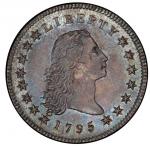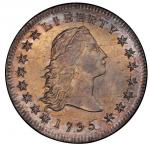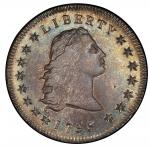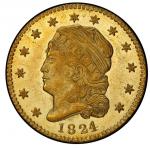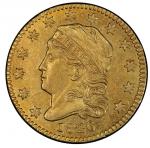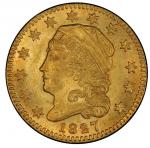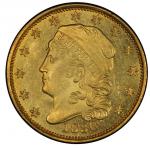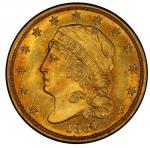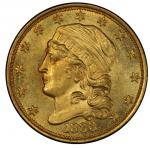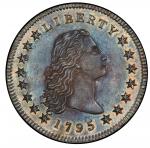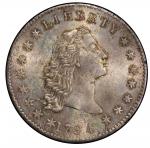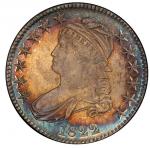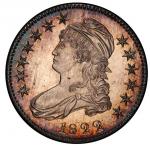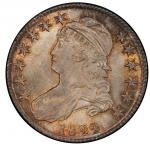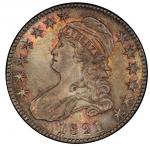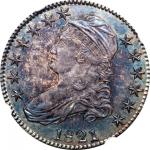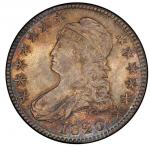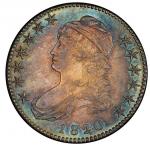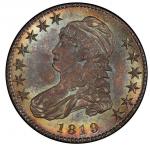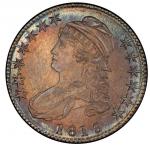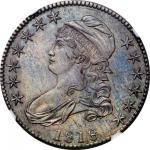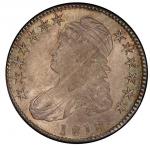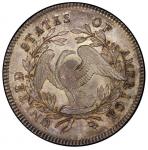Mr. Strickland has not been idle since he came to this country. … Nothing, I believe, has escaped his observation that merited notice.-- George Washington to Sir John Sinclair, July 10, 1795.A coin of great native beauty, like a tropical island or a mountain glen, natural and unsophisticated, showing no evidence of trespass from humans for centuries. The story of this coins provenance, long the stuff of legend, has now been brought into the realm of the factual by David Tripp, lending even greater meaning and romance to the Lord St. Oswald name. This coin, when acquired by William Strickland, was brand new. It remains so 225 years later. Its luster shows a variety of looks: reflective at the obverse periphery, satiny and a bit subdued at the central obverse, bold and bright across the reverse with both prooflike reflectivity and thorough frosty cartwheel. The obverse and reverse appear quite different, natural when the observer considers that this coin rested in a cabinet for a century and a half, rarely touched, never imposed upon. Deep gold toning, thick and beautiful, gathers around the obverse devices, a contrast with the deep pewter fields and the lighter silver brilliance that serves to divide deep gray from gold. Under a glass the golden toning appears natural, even primitive, including the area of light speckling in the central right field. The reverse exhibits an entirely different look, more subtly toned in brilliant silver and light gray, enhanced by familiar pastel blue and violet in the fields and close-cropped outlines of gold around design elements. The strike is superb on both sides. The obverse portrait must have been as satisfying to the coiner as it is today for the collector, detailed and well-realized. The stars each show their centers, though a few show traces of adjustment lines that truncate their highest relief. Adjustment marks are also present high in Libertys hair, upon her forehead, around much of the perimeter, and on her chin. Two particularly long parallel adjustment marks run from the rim outside star 10 to the field above Libertys forehead. The reverse is also very boldly struck up, showing only the merest flat spot on the eagles breast and some weakness on the eagles talons, while other design elements are as complete as can be. A tiny curved lint mark is seen at the base of the reverse, a bit closer to the right ribbon end than the left. A short scratch is noted outside the right ribbon end. The obverse shows some subtle hairlines, while the frosty reverse is completely free of them. A few minor marks, including a tiny contact point above the eagles head, amount to nothing individually or taken as a whole. Struck from a crisp early state of the dies, this coin shows a wealth of fresh detail. Both of the tiny flaws at the end of the left ribbon end, hallmarks of this die state, are still present.The adjustment marks on this piece tell only half the story of this planchets preparation, which could serve as a summary of the story of precious metal planchet production during the first 12 months that the U.S. Mint was striking coins from compositions more noble than copper. Underweight when made, this planchet was fitted with a plug of silver to bring it up to proper weight. Though barely visible on the obverse even when carefully studied, located astride two tresses behind Libertys ear, the plug is much broader on the reverse. What was once a small mound has become, from the impact of striking, a substantial circle, centered at the juncture of the eagles body and wing at right, distinctive in form and easy to see. Its darker violet color seems to suggest that the silver fineness of the plug is different from that of the rest of the planchet. Tests cited in Kenneth Bressetts paper for the 1993 Coinage of the Americas Conference "showed that both the plug and the coin were made of the same alloy" in most cases, though "with one specimen, the plug was of higher fineness; a second specimen contained a plug of lower fineness."Among all 1795 dollars certified by PCGS, only one specimen has ever been graded finer: the coin in the previous lot. This is the finest 1795 Silver Plug dollar known. Plated in Walter Breens Complete Encyclopedia and Encyclopedia of United States and Colonial Proof Coins, Breen called this coin a presentation piece based upon the speculation that Major the Lord St. Oswald was a VIP who received this coin "on the occasion of his visit to the Philadelphia Mint about October 1795." The truth of the Lord St. Oswald provenance involves a different but equally captivating narrative: that of William Strickland, an English polymath and collector typical of so many of his brethren during the Enlightenment, who acquired fine specimens of then-current coins to place in his cabinet upon his return home. Strickland certainly could have visited the Philadelphia Mint. He arrived in Philadelphia a few weeks before the end of 1794. "By December 22," David Tripp has discovered, "Strickland had already once attended a debate in Congress," held at Congress Hall at 6th and Chestnut. Philadelphia, capital of the United States until 1800, was a populous but compact city in the late 18th century. Congress Hall was just three blocks away from the Mints home at 7th and Filbert streets. Having already made the acquaintance of William Seton, a powerful New York banker who was an intimate of Alexander Hamilton, and bearing letters of introduction to President Washington, Strickland was well-connected. With relationships to people at the highest echelons of power and nothing to do but sightsee in Philadelphia between December 1794 and April 1795, a visit to the Mint crosses the threshold from possible to likely, though it remains entirely speculative.While the main purpose of Stricklands trip to America was to examine the countrys landscape and agriculture, he spent his ten months in the United States visiting sites of industrial, historical, and commercial interest, spoke to all manner of people, painted, wrote, and explored. Strickland recorded in his journal that, while in Philadelphia, he planned to "add to his collection" of seeds to take back to his experimental farm in Yorkshire, for which he departed at the end of July 1795. As we know, seeds were not the only thing he collected during his visit. He left for home from Philadelphia, having spent most of the first week of July and another week and a half prior to his departure in the City of Brotherly Love. While in town, deliveries of over 20,000 dollars are recorded in the logs of the Philadelphia Mint. Between May 6, when the first 1795 dollars were struck, and his embarcation on July 29, a total of 99,030 silver dollars were coined. By the time July 1795 ended, this coin was already a collectible. When the calendar turned to August, it was already aboard the Camilla on the first leg of a journey whose return leg would not be scheduled until 1964.The Jack Collins and Walter Breen book on 1794 dollars mentioned that the Lord St. Oswald 1794 dollar was last seen "at the bourse table of RARCOA/Ed Milas, Jr. during the 1987 ANA Convention in Atlanta." That reference appears to be a mis-recollection of this coin, dated 1795, which was on display at the RARCOA booth at the 1987 ANA Convention. The Lord St. Oswald 1794 dollar had already been off the market in the D. Brent Pogue Collection for two years at that time.

